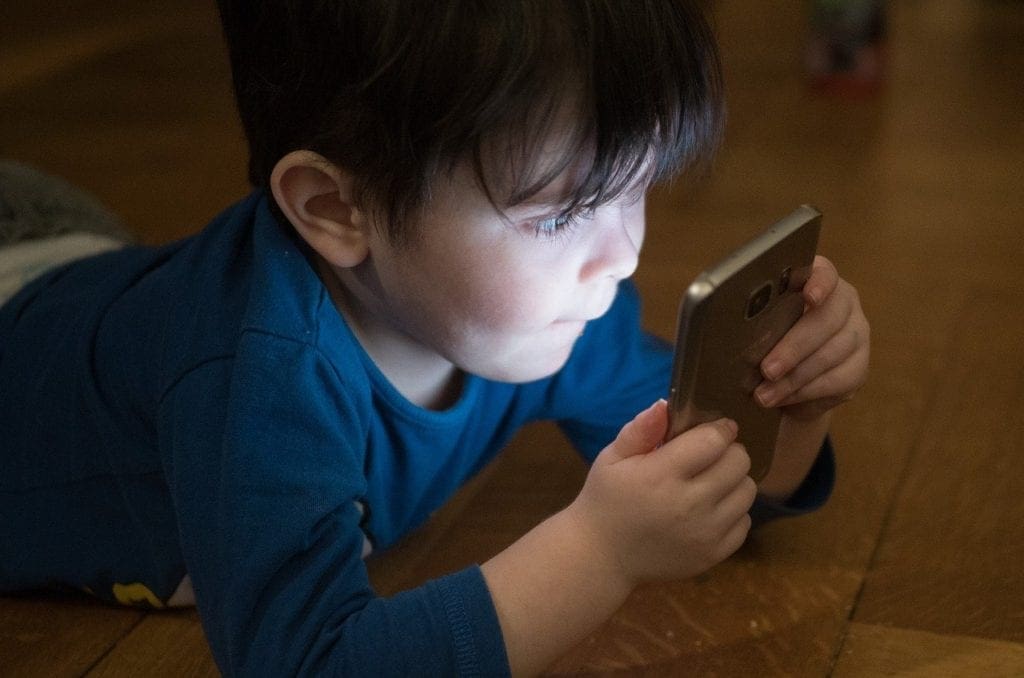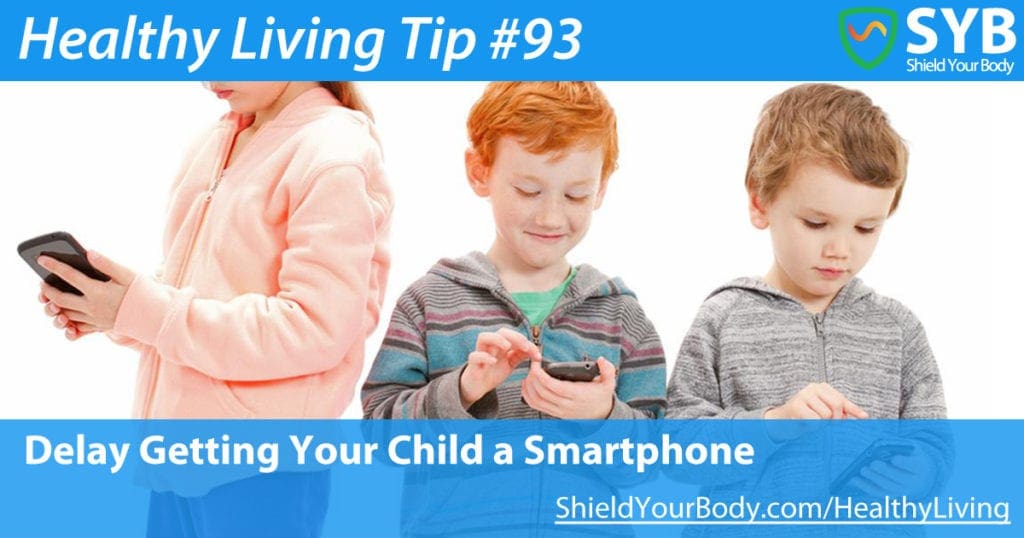If you are a parent and your child is in their pre or early teens, this question has certainly crossed your mind at least once: “Is my child ready for a smartphone?”.
As parents, we don’t want our children to fall behind the learning curve. And more often than not, we decide to put a cell phone in their hands.
A 2019 US statistics report found that 53% of children owned a smartphone by age 11.
In other words, the majority of the child population is engaging with the virtual world – possibly even preferring it to the real one. This can be problematic. The pre-teen phase is essential in the development of emotional intelligence, and smartphones compromise that phase, contributing to an array of problems for the child as they grow up.
However, we also can’t blindly deny that giving our child a smartphone has some positive effects. The question is, do the benefits outweigh the risks?
Let’s find out the pros and cons of giving your child a smartphone.

Want toSlashYour EMF Health Risks?
Want to Slash Your EMF Health Risks?
Good! Learn the one small change you should make right now.
Positive Effects of Smartphones on Child Development
Smartphones open up a whole new world of endless possibilities for children where they can feed their curiosity. Being connected helps them with their studies, informs them, entertains them, and most importantly, helps them catch up with the fast-paced modern world.
Having a smartphone:
Helps them become self-reliant
Being self-reliant is an important skill that a person can only learn through experience. According to research, how independent a person will becomeas an adult majorly depends on how they are raised as a child.
Giving your child a smartphone could be an opportunity for you to teach your children to do certain things on their own.
For example, you can teach them how to search for answers on the internet. The internet will answer most of their questions, and most importantly, it will lead them to find solutions to their minor problems by themselves.
Makes Them Digitally Literate
Technology is ever-changing, and understanding the basics of tech is crucial. If a child uses a gadget like a smartphone at a young age, the basic knowledge they gain will prove highly beneficial to them as they grow up.
Tech savviness is a skill of high value and will only become more so in the future. If your child is not digitally literate, it can be challenging for them to catch up with the modern world when they step outside on their own.
Gives Them Instant Access to Emergency Services
In case of an emergency, your child can quickly contact you or other people to help with the immediate situation.
Besides that, it will be easier for you to get in touch with your child quickly when needed.
This is why the American Association of School Administratorsrecommends that school districts let students have phones on them during the school day. The reason being, if there are any emergencies, there can be an accessible channel of communication between emergency handlers, parents, and children.
Adverse Effects of Smartphones on Child Development
As a parent, the responsibility falls upon you to decide what’s best for your child. And it’s important that you are well informed, because your decision to give your child a smartphone can have long-term effects.
From obesity to anxiety, smartphones are known to create a number of issues in children. These can have a huge impact on their physical and mental growth.
While some problems can be medically treated, issues like reduced vision can last a lifetime.
Here, I’m listing a few adverse effects of using smartphones at a young age. So, even if you absolutely have to give your child a smartphone, you can at least make an informed decision and take necessary measures to minimize these effects.
Physical Health
The growth spurt timeline in children isapproximately 18-20 years, which means that their body continues to grow until then.
In this timeline, the body goes through several growth phases. And these are the critical ones because this is when the child develops qualities needed to survive later in life.
The pre-teenage and teenage years are also when their bodies are most adaptable, and it’s important to keep them physically active. Health experts recommend at least 60 minutes of aerobic activities like running, jumping, and playing sports per day.
Smartphones, meanwhile, cansuppress a child’s desire to do physical activities, which in turn prevents their complete physical development and creates health issues.
Less Physical Activity
13.7 million children and adolescents are suffering from obesity in the United States, according to a report by the CDC (Centers for Disease Control and Prevention).
WHO (World Health Organization) says that over340 million children and adolescents aged 5-19 were overweight or obese in a 2016 report.
Another 2019 report from WHO says that 38 million children under the age of 5 were overweight or obese.
Obesity has become a serious problem in children all around the globe.And the primary reason for this is the lack of physical activity and unhealthy food choices.
There is atheory among health experts that this behavior is correlated to the heavy use of mobile devices in children.
Technology today is designed toengage a user for as long as possible without considering the user’s health. Whether it’s video games or social media, everything is designed to keep the user’s attention glued to the screen.
Social media and video game companies achieve this by triggering smalldopamine activity in the user’s brain.
Dopamine is a pleasure hormone the brain releases whenever we achieve something. It is responsible for our behavioral and physical functions, such as:
- Learning
- Motivation
- Mood
- Attention
- Pain processing
- Movement
For instance, let’s say your child is playing a new video game, and their character rises a level. A small dopamine activity occurs in their brain, which gives them a pleasant feeling of success. As the child continues to play the game, the brain accepts the video game as a dopamine release source.
After a while, the brain gets addicted to easy dopamine releases orinstant gratification, incentivizing the child to play the game for even longer.
Since dopamine is the primary source of human motivation, the child can then lose interest in other things – like physical activities, interacting with people, and building relationships – preferring instead to stick to their devices.
Eye Problems
Prolonged smartphones use increases the risk of myopia.
It’s good, to some extent, that children are getting more tech-smart. It’s common to see children aged less than 3-years-old unlocking and playing games on smartphones without help.
On the other hand, heavy exposure to screens at this young age is not suitable for them. It can create a number of health issues, and unlike older adults, they have to live with those issues for an extremely long time.

Chonnam National University Hospital performed a study in which they examined the effects of prolonged smartphone use in children. The researchers found that children between ages 7-16 years who spend four to eight hours each day on a smartphone have a higher risk of becoming cross-eyed.
This is because young smartphone users hold their phones very close to their faces – statistically, eight to twelve inches.
Further explaining the reason, they said, closely watching the smartphone screen makes the eyes focus inward, causing them to cross temporarily.
Luckily, this condition is not permanent, and the researchers were able to reverse the side effects in subjects just by limiting or discontinuing the use of smartphones for two months.
They said that you could prevent this condition in your children by limiting their cell phone use to 30-minute intervals, followed by a short break to rest the eyes.
Additionally, you can encourage them to hold their phone a bit further from their face, so their eyes don’t need to turn inward to focus.
Musculoskeletal Pain and Discomfort
A 2013 study found that children who use cell phones for more than 2 hours dailycan develop lower back and neck pain. The study further reveals that continuous cell phone use is associated with asymmetrical postures and disruption in proper bodily growth.
Heavy EMF Exposure
Smartphones use EMF to connect with cellular and WiFi networks.
EMF is harmful to everything that lives. No human, flora, or fauna is safe from its adverse effects. And there arethousands of scientific studies backing up this statement. Prolonged exposure to EMF radiation"Radiation" in the context of Electromagnetic Fields (EMF) refers to the process by which energy is emitted and transmitted through space or a material medium in the form of electromagnetic... initiates an array of health issues ranging from sleeping disorders to chronic diseases like cancer.
And children are even more vulnerable.
During phases of growth in children, cells divide and replicate at a much higher rate than adults. This process is called cellular mitosis. EMF radiation from WiFi devices such as cellphones, tablets, and BluetoothFrom the perspective of someone concerned about the health effects of electromagnetic radiation, understanding Bluetooth radiation is crucial, especially in our increasingly wireless world. Bluetooth technology, ubiquitous in our daily... devices have been known to actually cause genetic mutations in DNA during cellular mitosis.
Since children have higher rates of cellular mitosis than adults, this DNA damage replicates more rapidly through their bodies.

Another significant physiological difference between children and adults, when it comes to the health risks of EMF exposure, is that the skulls of children are smaller and thinner than those of adults, and they are still developing.
The skull is a natural protector against radiation. Since a child’s skull is thinner than an adult’s skull, children can be more susceptible to the damages that EMF radiation can cause to their brains. And since their heads are smaller, the radiation can penetrate even more deeply into the brain than with adults. This makes the risks of exposure much higher in children and young adults.
The best thing you can do to protect your child is tominimize their use of tech and maximize their distance from EMF-emitting devices.
Mental Health
Our mental health plays a significant role in how we think, feel, and act. If our mental health is poor, it dramatically affects our physical and social lives.
Everything we do or witness has a tremendous impact on our minds. We may not analyze and make sense of how our surroundings affect us, but our unconscious mind notes, stores, and interprets everything we do and see.
Smartphones indeed have the world zipped in a small compact device for everyone to explore, but those same devices have more than once proven to be disastrous for our mental health.
From social anxiety to depression, many health experts credit smartphones for these conditions in children, as smartphones are believed to interfere with the natural growth pattern.

Lack of Emotional Intelligence
Humans are social animals. We’ve evolved to live in groups and support each other physically and emotionally, in peaceful times and in times of crisis.
We are also complex emotional beings. Linguistic and verbal intelligence is not enough to communicate with each other at a deeper level: for this, children develop emotional intelligence as they grow and interact with other people.
There are no apps or books that can teach a child how to read emotional cues and react to emotional situations. Their emotional intelligence can only develop by being socially present.
Smartphones substitute face-to-face interaction with texting, social media messaging, and rarely phone calls. So, when children lack this emotional development, it becomes complicated for them to adjust and fit in socially as an adult.
The University of California, Los Angeles, performed a research study to understand the effects of smartphones on the development of emotional intelligence in children. They kept 54 pre-teens in a camp without access to any electronics for five days.
They took a test before and after the children spent five days exploring nature. The test was to infer emotional states from photographs of facial expressions and muted videotaped scenes.
After spending five days with other children and without screen-based media, their ability to recognize nonverbal emotional cues in both photographs and videotaped scenes notably increased.
Patricia Greenfield, a distinguished professor of psychology at the UCLA College and senior author of this study, said the following: “Many people are looking at the benefits of digital media in education, and not many are looking at the costs.”
Social Anxiety
Social anxiety is a common problem today. Anxiety and Depression Association of America (ADAA) says that25.1% of children between 13 and 18 suffer from some form of anxiety disorder in the United States.
Symptoms of social anxiety include, but are not limited to, the following:
- Fear of eating in public
- Fear of speaking in public
- Fear of being the center of attention
- Fear of talking to new people
- Fear of going to school
- Fear of being judged, humiliated, and made fun of
To many of us, a simple task like going up to someone in a social setting and introducing ourselves doesn’t seem like a big deal. But to a person with social anxiety, it’s a frightening prospect.
Their mind forms so many imaginary scenarios of them being shamed, humiliated, and laughed at. They think it’s better to hold back.
Over the years, the number of people with social anxiety has increased dramatically. Some experts believe that there is a correlation between the use of smartphones from an early age and social anxiety.
Smartphones substitute human interaction with screens and train people to fear social situations.
Undoubtedly, smartphones aren’t the only reason why people develop social anxiety. But, the use of smartphones from a young age certainly seems to play a role.
Exposure to Inappropriate Media
In 2014 BBC UK did a survey in which they asked 2000 people from ages 11 to 25 if they have watched any sort of inappropriate online materials. During that survey, more than 50% of the children between 11-17 years old admitted to having watched some form of inappropriate media.
Smartphones make it extremely easy for children to come across inappropriate materials.According to the Pew Research Center, only 39% of parents use parental controls to block, filter, and monitor their children’s online activities.

Cyber Bullying
Today, cyberbullying is a growing concern. 2017 research byElizabeth Englander says that giving cell phones to young children increases their chances of becoming a bullying victim or a bully themselves.
The internet gives people a layer of anonymity, which is why cyberbullying has been a major concern in the modern world.
From verbal harassment in social media to the exploitation of children’s innocence in shady community threads, the dangers are many, and increasingly severe cases of cyberbullying have come to the surface in recent years.
FOMO – Fear of Missing Out
FOMO is a condition that makes a person anxious when they feel they’re missing out on something. Social media apps nowadays are factories for producing FOMO.
FOMO is harmless at first glance. But it can take an unpleasant turn and start to affect the person’s mental health seriously. Children are most vulnerable to this.
They go on social media and see various posts from the so-called ‘social media influencers’ living a ‘cool’ lifestyle. This creates FOMO in children, and the desire to become like those influencers increases day by day.
FOMO increases up to and beyond a point where children have resorted to taking illegitimate actions, like stealing from their parents, other people, and shoplifting to fulfill their fantasy lifestyle.
Another example of FOMO can be seen in in-game purchases. Multiple parents have reported incidents in which their children used their credit cards without authorization to purchase in-game items. When asked, children said that they feared being made fun of if they didn’t reach the same level as their friends.
FOMO is also considered a mental illness by some experts because it can lead to issues like loneliness, feelings of inferiority, reduced self-esteem, extreme social anxiety, and increased levels of negativity and depression.
Decreased Academic Performance
One recent study conducted at Rutgers University in New Jersey found that cell phones in the classroom led to a notable drop in academic performance, reflected in lower grades.
“Many dedicated students think they can divide their attention in the classroom without harming their academic success,” said lead researcher and professor of psychology Arnold Glass in a press release, “but we found an insidious effect on exam performance and final grades.”
School Bans on Cell Phones
We’ve already seen an increasing number of schools banning WiFi to protect students from harmful EMF radiation. With cell phones presenting a danger as well as a distraction, it’s only a matter of time before something must be done to limit their use in classrooms.
And in fact, that’s already happening. According to a US Education Week analysis, more than 30 schools – or in some cases, entire districts – had enacted cell phone restrictions during the 2019 school year.
In Ontario, Canada, a restriction on cell phone use in classrooms came into effect in November 2019. And in September 2018, the French government completely banned the use of mobile phones in schools.
China Bans Cell Phones in All Primary and Secondary Schools
As another noteworthy example, the Chinese Ministry of Health issued a public notice on February 1, 2021, invoking a ban on cell phone use during school time. The ban applies to both elementary and secondary school students. The notice also encourages teachers to refrain from using cellphones to assign homework.
The ministry said that they took this decision to increase students’ focus on studies, protect their eyesight, and prevent them from getting addicted to the internet and video games.
This ban has been a topic of debate among parents. Some of them say that if their children are not allowed to bring cellphones to school, it will push their children behind the curve in this technology-led era. Others agree that cellphones are an unwanted distraction and a threat to their child’s health.
Seeing that the communication between students and parents is also important, the ministry encourages school authorities to install public telephones on campus and use electronic student IDs with call functions.
In addition to the official statement, the ministry said that “parents need to be the life guide for their children and encourage them to develop hobbies such as reading, art and sports, and to consider carefully before equipping their children with mobile phones.”
Is My Child Ready for a Phone?
So, in light of all of the above, should you give your child a cell phone?
As we’ve seen, there are certainly some compelling reasons to hold off on answering ‘yes’ for as long as possible. But, due to the pandemic, that may no longer be an option – a fact that’s been causing some major problems. Have a look.
2021: Side Effects of Pandemic-Increased Screen Time
Since the pandemic has inverted almost everything, getting your child a smartphone may no longer be a matter of debate. It’s thanks to technology that our children have been able to carry on their education and the social aspects of their lives, even during government-issued lockdowns.
However, there are two sides to this coin. Tech has certainly proven to be extremely beneficial to our children. But on the flip side, their reliance on all sorts of gadgets increased significantly.
Screen times have increased, digital monitoring has been loosened, and kids are spending more time on social media, VoD services, and gaming platforms than ever before. And that’s just part of the problem.
The pandemic-induced increased screen time has attracted a swarm of tech giants who hope to capitalize on this situation by using psychological tactics to keep children hooked on screens.
The Digital World Comes with a Price
You may have heard of a game called Roblox. It’s a popular online game where users can create their own mini-games and socialize with their friends. The majority of Roblox users are aged from 9 to 12 years.
This game connects users with Roblox content creators directly and allows fans to pay their favorite creators from right within the app. In addition, they also have in-app purchases. And because of this, a vast number of children are spending real money on these payments, sometimes without permission.

Check out these stories from parents who had to pay huge bills because of purchases their children made in Roblox.
Richard Walters, a father of a 10-year-old girl, woke up to a $7,200 bill for purchases made over two months of lockdown. “Over the course of two to three months, there was an exponential process in both the frequency"Frequency" in the context of electricity, Electromagnetic Fields (EMF), and wireless communication, can be thought of as the number of times something happens in a second. Specifically, it refers to... with which our daughter was buying currency and the amounts she was purchasing — it started at $1 here or there, but by the time I realized what was going on she was buying Roblox currency in $120 denominations and had bought eight lots that very day,” said Walters.
Sarah Louise Petty, from Larchmont, New York, discovered that there was a payment of $1,250 to a third-party app from her bank account. Later she realized that her son had bought items in Roblox.
There are many stories like this.
But money spent on in-game items and creator payments is not as much of a problem as what happens after they spend that money. Per experts, purchasing these items without permission can induce fear of getting caught and guilt in children. And that’s not good for their mental health and well-being.
Also, it’s not just Roblox. Many online multiplayer gaming platforms follow the same pattern. So, what can you do?
What Can You Do?
Having gadgets like smartphones, tablets and laptops is necessary for our children right now. But even then, there are things that you can do to protect them from digital technology-induced physical and mental health problems. Here are some of them.
Focus on the Content
The digital world is wild. There’s cyberbullying, graphic content, and things that may not be suitable for your child’s mental health. I can understand that getting along with new technology can be challenging for some parents, but it’s not something that you can’t learn. You need to ensure that you’re aware of the content they’re interacting with on their gadgets.
A simple Google or YouTube search can give you a ton of information about whatever your child is doing online.
Encourage Offline Hobbies
Although the pandemic has limited outdoor activities for many, there are things that you can do with your children to keep them off their gadgets. For instance, you can get into arts and crafts, do some gardening, teach them how to cook and other life skills. Find enjoyable things that they can do with you while still learning.
Be a Role Model
Make sure there’s a time in your day when no one in the house uses any form of electronic gadget. Simply set a time that works, and go offline. Be conscious of your own tech use so you can become a positive role model to your children.
Talk to Them
This is probably the most important thing that every parent should be doing at this moment. Since you’re an authority figure, they may have difficulty communicating if they think they’ve done something wrong. Always make sure to let them know that it’s okay to make mistakes, and making mistakes is how they learn.
You need to create a comfortable space for your children to share whatever’s going on in their minds. And the best way to do this is to start talking to them and trying to understand what they’re going through.
Final Thoughts
Gadgets like cell phones have a lot of physical and mental health effects. But if used in the right way, they can add a ton of value to the lives of you and your children. I invite you to listen to our brand-new show called “The Healthier Tech Podcast,” where experts from the medical and EMF industry teach how to build a healthier relationship with technology. We’re available on all major platforms, and you can tune in today for free.










